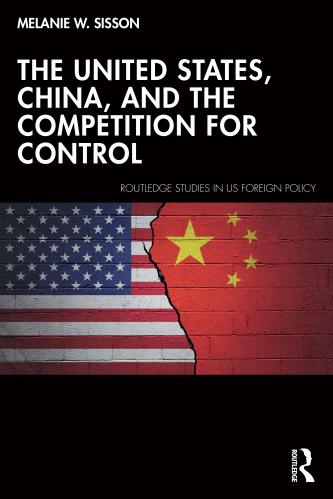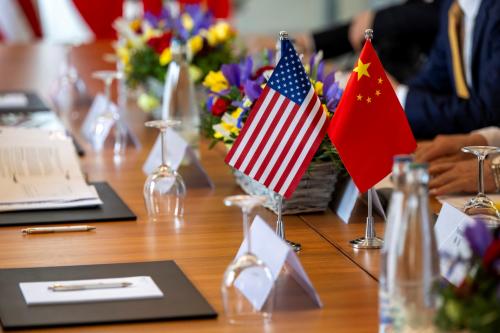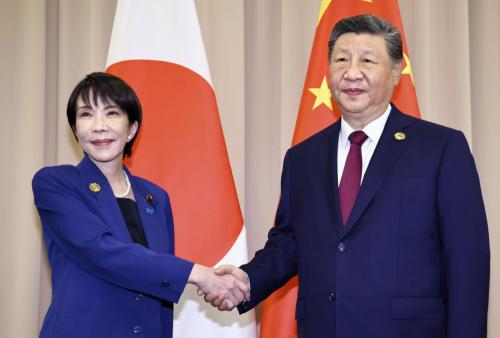In this roundtable review of “The United States, China, and the Competition for Control” by Melanie Sisson, seven experts examine the question of whether the United States and China have irreconcilable visions of world order.
On China and the world, America has a choice
In her new book, “The United States, China, and the Competition for Control,” Melanie Sisson takes a bold but nuanced stance, calling for a reconsideration of the conventional wisdom among U.S.-based China analysts. They usually make the assumption that China is on its way to overthrowing the postwar order and replacing the United States as the sole global leader, and that China seeks to do so through the expansion of military power. Sisson calls on American policymakers to reexamine these views and assumptions.
Sisson contends that China’s historical engagement with the post-World War II international order is best described as “deviance within acceptable levels.” According to her, the People’s Republic of China’s behavior has neither been as disruptive as often portrayed in Western narratives, nor as exemplary as it claims in its own official discourse. Given that China has both benefited from and partially invested in the postwar order, Sisson argues that it is in the United States’ best interest to bind China into existing international institutions and engage in bargaining over the rules of the game.
Sisson also cautions American policymakers against uncritically cherry-picking statements and speeches by Chinese leaders that, when taken out of context, appear to confirm existing assumptions. One consideration that can be added to her argument is whether such rhetoric is primarily intended for a domestic audience or for foreign observers. Many of the so-called “wolf warrior” remarks made by Chinese officials may be better understood as efforts to stoke domestic nationalism and build regime support, rather than as concrete expressions of foreign policy intent.
Facing the challenge of globalization and China, Sisson provided us with two possibilities: either the United States chooses to move away from the world it created, or it can recommit to the postwar order and readjust the distribution of benefits and responsibilities. However, the United States seems to have already made its choice. Consumed by the narrative that postwar, free-trade multilateralism mistreated it, the United States is gradually giving up on the world it created and increasingly retreating from the postwar order. We have recently seen attempts by the United States to not only isolate itself but actively undermine the very order that promoted peace and prosperity around the globe for decades since World War II. The United States is on a trajectory of unwillingness to cooperate within the order and has turned to indiscriminate protectionism and bilateralism, causing tremendous instability between the United States and its long-term allies. This may not change the nature of global competition between the United States and China in the coming decades, but at a minimum, it has substantial implications for the potential supporting role that U.S. allies and partners can play.
Sisson points out that “the United States has ample means—including the post-war infrastructure, robust relationships with allies and partners, and America’s own considerable strengths—through which it has and can continue to influence China’s behavior,” and further argues that the United States should aim not to convert China’s own interests but to disincentive China from using force to pursue them. However, in light of recent shifts in U.S. foreign policy, if Washington has indeed begun to abandon the first two pillars of its influence—multilateral institutions and allied partnerships—what remains is the third: the United States’ own unilateral economic and military power, which tends to be coercive in nature. The trajectory and outcomes of the U.S.-China competition will therefore be shaped in no small part by how the United States chooses to project itself on the global stage.
Going against the herd
In her new book, “The United States, China, and the Competition for Control,” Melanie Sisson unflinchingly positions herself in front of a stampede and shouts for the herd to stop and think about where it is heading. The herd—the U.S.-based China-watching community—has broadly coalesced around two suppositions relating to China: first, that China is bent on upending the post-World War II international order; and second, that China is determined to displace the United States to become the world’s unchallenged leader. Sisson urges American leaders to examine both these suppositions with greater dispassion and self-awareness.
She observes that China has disproportionately benefited from the stability and the free flow of goods, capital, and ideas that the international order has provided. She concludes that the “PRC’s record of compliance with the principles and institutions of the post-war order is neither as bad as U.S. discourse would suggest nor as good as Beijing’s presentations would contend.” Instead of casting China as being in league with Russia and other discontents who are determined to tear down the existing order, Sisson instead urges American leaders to “capitalize on China’s attachment to the current order” by drawing Beijing into negotiations over how best to adapt the system to modern-day realities.
Sisson also warns the American policy community against casually accepting curated excerpts of statements by Chinese leaders, scholars, and state media as smoking gun evidence of Chinese ambitions to displace the United States on the world stage. She argues that Chinese leaders’ quotes are often clipped out of context and stylized to support American scholars’ prior convictions. While much of the China-watching world has accepted an expansive interpretation of China’s ambitions, there is not a universal consensus around the scope of China’s aims. Sisson is right to observe that this topic remains contested.
Instead of accepting as given that China is bent on a zero-sum struggle with the United States for global primacy, Sisson instead concludes that China’s aims are more modest. She asserts that China is determined to resurrect its status as a leading power on the world stage and reconstitute its claimed territories, including those that overlap with American allies and partners such as India, the Philippines, Japan, and Taiwan. Her verdict is that “some of these [PRC] behaviors challenge U.S. interests and some of them are offensive to liberal principles, but this does not make them an assault on the post-war order.”
In the process of prosecuting her case, Sisson may overstate the degree to which China is willing to accept constraints on its ambitions in service of respecting the rules, norms, and institutions that comprise the postwar international order. Sisson argues, for example, that China has largely adhered to and invested in the postwar international economic order, which is true up to a point. Yes, China has accepted rulings from the World Trade Organization and contributed to the International Monetary Fund and the World Bank. At the same time, China has shown an unwillingness to adopt economic disciplines that would keep the international trading system viable, instead bulldozing forward with a state-led economic system that has generated distortions so large as to call into question whether the system itself can remain viable. Similarly, on China’s maritime disputes in the South China Sea, China has shown an unwillingness to be bound by international rules, instead resorting to intensifying coercion and threats of military force against other claimants who stand in the way of China’s assertion of control over contested territories.
Sisson closes her book with a call for America to do better. If the United States wishes to lead, then it needs to attract followers. America’s fixation on countering China is crowding out its focus on building support for its vision of the future of Asia and the international order. America undermines its own attraction when it attacks its allies, repels foreign students, and destroys key foreign policy instruments such as the U.S. Agency for International Development and Voice of America. Other countries need to be convinced that what is good for America is good for them, too. If they are not, Sisson warns, then other countries will hedge by moving closer to China.
U.S.-China progress is possible
As President Donald Trump’s tariffs upset the world economy, Beijing has been on the offensive, casting China as the defender of the global economic order and a stabilizing counterweight to an increasingly unreliable United States. This is, of course, an inversion of the popular Washington narrative that asserts just the opposite, that China is the upstart disruptor and the United States the status quo power.
Melanie Sisson’s “The United States, China, and the Competition for Control” argues convincingly, however, that the reality is much more complicated than either of these simple accounts suggests.
Challenging conventional wisdom, Sisson shows that the record of U.S. and Chinese compliance with the postwar order is not one in which the United States mostly adhered to prevailing norms and rules while China mostly violated them. Instead, although Washington played a central role in setting up many of the most powerful postwar institutions, the United States has frequently pushed back against the existing system when its leaders deemed it necessary. For its part, Beijing has certainly chafed under the constraints of the U.S.-led global order and refused to follow standards it found disadvantageous. But, as Sisson notes, “far from opting out or seeking to obstruct or overturn the post-war order’s institutions, China integrated itself into them and from there, worked within their procedures to gain and exercise influence.”
Sisson’s well-researched book makes three crucial points. First, Sisson shows that China’s compliance with and resistance to global economic and security rules have changed over time and differ across issues according to its own interests and not always or only in response to the United States. An elaboration of China scholar Alastair Iain Johnston’s contention that China sees not one but many separate international orders, Sisson’s nuanced take is urgently important for policymakers seeking to work and compete with China across domains.
Second, Sisson’s review of China’s attitudes toward the postwar international system and its own forays into “order-making,” with organizations like the Global Security Initiative and the expansion of the BRICS bloc, suggest that while Beijing may hope to displace parts of the U.S.-led order, it does not want to replace it entirely. Some China hawks argue that Beijing seeks to eventually supplant the United States as the global hegemon, but Sisson finds little evidence of this. Instead, Sisson shows, even as China struck out on its own, China has not pulled out of U.S.-created institutions or forced countries to choose between Beijing and Washington. Instead, it has filled spaces the United States neglected, like investment in global infrastructure development. It, therefore, seems possible for Chinese-led and U.S.-led institutions to coexist.
Third, Sisson urges readers not to fear changes to the international order that reflect the new global balance of power but warns that the primary goal of any new order must remain the same as that of the old: avoiding a war between nuclear powers and, in particular, the United States and China. This objective does not require that the United States and China agree on everything, however. Beijing and Washington can continue to disagree about human rights, domestic politics, and climate issues, as long as they can reach a stable equilibrium on important security and economic challenges like Taiwan and trade. Such an understanding would, Sisson acknowledges, require some compromises. On the U.S. side, the rhetoric about “containing China” would need to be replaced by a willingness to treat China as a co-equal great power. China, in turn, would need to accept that the United States will not leave Asia, a region where it has long-term interests.
Trump’s trade war has thrown a wrench in the near-term prospect of a U.S.-China agreement on elements of a new international order, but ultimately, Sisson’s book gives readers reason to remain hopeful that progress is possible in the longer run.
A welcome corrective
Melanie Sisson has approached the subject of U.S.-China relations in the 21st century with the wisdom of Bernard Brodie, the elegance and strategic empathy of John Steinbruner, the wide-ranging knowledge of America’s best national security thinkers (of which she is one) like Henry Kissinger, and the clarity of thought that President John F. Kennedy displayed during the Cuban missile crisis.
Let me unpack each of those points. But first, please allow me to underscore: this is not hagiography. I do not agree with every one of my good friend Melanie’s assessments. I think she is somewhat too forgiving of China’s recent behavior and at least slightly too critical of our own (at least through 2024, the time of publication). But this fine book is a welcome corrective to the new American narrative on China: that it is an evil foe to be confronted at every turn. Melanie does well to remind us to be careful about such thinking, tempting as it may be.
As for Brodie, he rightly recognized that in the nuclear age, the goal of great power defense establishments must be to avoid war (or bring it to a rapid close if it begins). There are still too many at the Department of Defense and beyond who think victory in a U.S.-China war is a plausible goal in any conflict. I agree with Melanie that war avoidance, and de-escalation, should take decisive precedence.
Second, her willingness to avoid depicting China as “genocidal” or part of a new “axis of evil” is commendable. To be sure, China’s suppression of religious, minority, and dissident voices is sometimes terrible. But this is also a country, and a government, that has lifted hundreds of millions out of poverty and avoided major war for almost half a century. We need perspective. She conveys that perspective with a voice that reminds me of the late, great Steinbruner, my first boss at Brookings and a man of remarkable vision.
Third, Melanie understands the power—and interdependence—of the two countries at issue here. In military terms, Americans of recent generations risk thinking of war fundamentally with reference to Iraq and Afghanistan, Panama and the Balkans, and al-Qaida and ISIS. Melanie thinks, as Kissinger did, in much broader historical and strategic contours when analyzing the challenge China poses for America today. She knows that neither side could ever confidently expect to defeat the other definitively should war occur. There are far too many uncertainties and unknowns.
And finally, these insights lead Melanie to the same conclusions Kennedy reached in the Cuban missile crisis of 1962: we must stay calm and flexible—and even willing to compromise, as long as our core principles and interests remain intact—in handling the road ahead with the People’s Republic of China. The future of the human race depends on how well we succeed.
A better metric for assessing China
In their reviews of Melanie Sisson’s thoughtful book, my colleagues have focused their attention on her account of China and the U.S. framing of Beijing’s strategy. I share much of their adulation and some of their critiques: like Michael O’Hanlon, I think Melanie is slightly too forgiving of Beijing. But just as important is her effective skewering of what had become a shibboleth in the discourse about the United States itself: the notion that American foreign policy is or has been oriented toward the defense of the rules-based international order.
I was serving in the United Nations when I first heard an American diplomat argue that U.S. foreign policy was organized in defense of the “rules-based international order.” I could not restrain myself and laughed out loud. Later, my boss chided me: “Bruce, it is not wise to laugh at the Americans. They run the world.” But the notion was so absurd on its face that I could not check the outburst.
Let me be clear: I hew to the view that American foreign policy during the short, post-Cold War peace was both (a) far more benign than should be expected of a dominant power in world affairs, especially one both victorious in a recent, long contest and then untrammeled by peer rivals, and (b) far more often a force for good than a force for ill. I am, of course, aware of all the exceptions. But in the post-Cold War period, someone wanting to pursue peace (or humanitarian response) in a given region, advance the cause of multilateral cooperation, or tackle a thorny problem of global public goods could reliably find allies and support in Washington, which also paid for a huge proportion of the exercise of international stability, trade, and cooperation.
But at no point was international law or the multilateral system the North Star of American foreign policy, and to argue that it was is both to smooth over far too many obvious exceptions and to misunderstand the essence of what Washington’s policy class was trying to pursue. That is to say nothing of the fact that if you ask four American policymakers to define the rules-based order, you will either get blank looks or four separate definitions, most of them ahistorical.
Melanie’s book wisely takes us back to the essential question of international order, which is not international law: it’s great power peace.
Now, an order designed to avoid great power war can have within it an awful lot of smaller wars, regional wars, and proxy wars—as the Cold War did, at a huge cost. If the primary measure of an order is whether it helps avoid great power war, a secondary measure should be whether it helps avoid (or manage, limit, or end) smaller wars. By this measure, I judge American foreign policy in the first part of the post-Cold War period (pre-9/11) as largely benign and permissive of other states’ efforts to pursue such goods; in the post-9/11 phase, the record is much more mixed, and in the Middle East specifically the track record is much worse. Still, no judgment of the U.S. role in the world can ignore the myriad ways in which the United States helped produce stability in Europe and Asia, helped end regional wars, or funded the lion’s share of humanitarian efforts. Similarly, in the world of trade—Washington was sometimes an opponent of further elaboration of the General Agreement on Tariffs and Trade/World Trade Organization rules of trade, but the massive wealth creation that global trade generated from the 1980s to recent days could not have happened without the market, finance, and underlying agreement of the United States. That the United States often bent the rules or bullied countries into compliance with rules that were heavily skewed in its own favor does not change the fact that U.S. power undergirded an amazingly effective system of wealth creation (one it now appears intent on tearing down, likely at great cost).
So, what does this mean for how we assess China in relation to the international order? Does Beijing follow international law or international rules in all cases? Melanie’s argument—with which I strongly concur—is that this is the wrong metric. The right metric is whether China’s policy advances stability, growth, and cooperation or their opposites—and how other countries assess its intent or outcomes. I am leerier of Beijing than she is, but time will tell. Melanie’s signal contribution is to focus our analysis on the right set of measures.
A herculean challenge that is well met
Melanie Sisson’s book is ambitious, in the best sense of the word. It challenges the one narrative in which a deeply polarized United States seems to have found consensus: that the United States, as the champion of a rules-based order, and a revisionist China, that is aiming to displace America and impose an illiberal project, are locked in unreconcilable strategic competition. And she takes on the herculean task of actually checking the empirical record by parsing Washington’s and Beijing’s compliance with the principles and institutions of the postwar order across the economic, security, and diplomatic domains, and along its evolution from the post-Cold War era to China’s rise. It is a tall order, and one well met by the book.
Another key strength of Melanie’s argument is her unromanticized accounting of the fundamentals of the postwar order as one geared to prevent another world conflict, not mandated to deliver global prosperity or secure universal human rights. In an era of weaponized economic interdependence, Melanie’s elevation of free trade multilateralism as a core principle of a system that has contributed to strategic stability is a sober reminder of the perils ahead. In an era of rising tariffs and the exploitation of supply chain choke points, we should consider ourselves warned of the costs of doing away with an order whose purpose was:
“To create an international economic system that might prevent recurrence of the kinds of chronic grievances and acute disagreements that had so recently contributed to crushing economic crisis and culminated in catastrophic war. Achieving this objective would require balancing the need of national governments to manage their own economies in order to maintain sociopolitical stability—to avoid civic unrest and minimize opportunity for the emergence of another round of virulent nationalism—but without creating effects that were so damaging to other nations that they initiated a chain reaction of mutually destructive practices.”
And yet, a deeper dive into the root causes of the current crisis of trade multilateralism would have clarified why we seem to have unlearned these powerful lessons. A broken American social contract is an important factor behind growing trade skepticism. While certainly true that the United States has weakened compliance with extant rules by neutering the World Trade Organization’s (WTO) dispute settlement mechanism, the reasons for U.S. disenchantment with the WTO could be fleshed out more. The obstructionism of other states such as India, South Africa, and China paralyzed the WTO’s trade liberalization and rulemaking functions. China has exploited regulatory gaps in the WTO to reify its state capitalist practices of providing subsidies to favored industries that no other country comes close to emulating. Beijing’s acts of economic coercion to advance political disputes and the flooding of markets due to Chinese overcapacity practices have raised concerns not just in the liberal West but among emerging economies.
The book focuses on the actions of the great powers, but the agency of other actors matters in defining the fate of the international economic system. For all of Beijing’s emphasis on self-resilience, a key driver of Chinese economic diplomacy is to avoid economic isolation and the bypassing of China through others’ diversification strategies. For all the harassment of trade partners as “cheating” America, Trump’s Washington cannot bring an industrial renaissance or outcompete China on its own. The great powers will continue to vie for control, but how others align, hedge, or innovate is indispensable to understanding the ultimate fate of the grand experiment begun 80 years ago. That we should care deeply about the fate of this international system is the book’s signal accomplishment.
Understating the China challenge
Melanie Sisson has written a thoughtful and provocative book that takes aim at the dominant view in Washington that China is the only country with the intent and increasingly the capability to overturn the U.S.-led international order, and that the United States ought to put strategic competition with China at the heart of its strategy and foreign policy.
As someone who has been deeply involved in writing about and working on strategic competition with China, inside and outside of government, I believe that Sisson significantly understates the challenge that China poses to the United States.
Sisson hinges her argument on whether China is really seeking to completely overturn the rules-based international order and its track record toward the order since World War II. She acknowledges the literature that concludes Chinese documents suggest that this is Beijing’s goal, but argues that the documents are open to interpretation, and it’s possible the troublesome statements are more observational than prescriptive.
Let’s take a step back and look in plain terms at what China is either doing or getting ready to do.
China is currently preparing to take Taiwan. The United States relies on Taiwan for the supply of chips for the artificial intelligence (AI) race, which has the potential to upend the global balance of power. Beijing is making plans to wage a war against the United States if Washington comes to Taiwan’s aid. As part of this, as Jen Easterly, the former director of the Cybersecurity and Infrastructure Security Agency has said, China is preparing to launch destructive cyber-attacks against U.S. civilian infrastructure, including “the pollution of our water facilities; the severing of our telecommunications; and the crippling of our transportation systems.”
We do not know if China will move against Taiwan if it feels like it has the capability. Sisson argues that China will be deterred by the fact that it cannot “be confident that it would win in any given contingency if the United States were to choose to engage.” Therefore, Beijing is only likely to launch an invasion if it worries that Taiwan is moving toward independence and feels backed into a corner. She may be right. But because we cannot know, we need to be prepared so we can deter China and sustain the status quo. This does not mean that the United States throws caution to the wind. Quite the contrary. But it does mean that we must be attentive to the plans China is making to launch attacks on U.S. critical infrastructure and options short of an invasion, like a quarantine, as well as its military efforts to produce a viable invasion plan.
There’s much more to justify alarm and a concerted effort to respond to the threat posed, including China’s economic coercion of other nations, its increasingly belligerent actions toward the Philippines and Australia, and its support for Russia in its invasion of Ukraine. Sisson does not mention this. Instead, in one section, she says that the People’s Republic of China’s military modernization “serves to deter a U.S. use of force,” implying the primary driver of tensions is a classic security dilemma where both sides lack revisionist intent.
On economic policy, Sisson argues that China is invested in the international order while the United States is moving away from it. She cites Xi’s statements in support of globalization, trade, and international institutions. But China, especially under Xi Jinping, subsidizes industries like steel, clean energy, digital infrastructure, and advanced biotechnologies on a massive scale. Moreover, as Brad Setser of the Council on Foreign Relations has shown, Xi has consistently avoided actions to boost Chinese consumers’ demand and has instead invested massively in manufacturing capacity and infrastructure, leading to an explosion in exports—what is widely referred to as the overcapacity problem. Other countries are unable to compete with China, and they are increasingly dependent on Chinese-made goods. Beijing has also engaged in a deliberate effort to corner the market on critical minerals and key components and to drive its international competitors that conform to market principles out of business. All of this created the conditions for the fracturing of the global economic order.
This is not just a U.S. concern. Europe largely shares this assessment and is more vulnerable to it than the United States. Some of China’s partners, like Brazil, have filed rare anti-dumping complaints about China at the World Trade Organization.
Finally, it is very unclear to me what policies Sisson is proposing or, indeed, opposing. She acknowledges that Beijing is not a benign actor and that the United States must keep a watchful eye on China, but she is primarily wary about an American overreaction. But what does that mean exactly? It’s not clear.
For example, Sisson’s sections on the Biden administration’s investments in the U.S. military, its deepening of U.S. alliances, and its export controls on China are very nuanced, but it gets to a point where it is very hard to discern the recommendation or how it differs from what is being done. Sisson seems to be saying that the United States is a highly capable military power, and that as long as it continues to invest in its capabilities and does not undermine its own alliances or try to restrict Chinese access to high-end technologies, it will be able to deter China from aggressive actions.
To me, that position is overly complacent. We have real vulnerabilities to address, including winning the AI race and shoring up the deficiencies of our defense industrial base, especially relating to our stockpiles of munitions. We have allowed China to dominate the critical minerals necessary for these efforts. All of these areas require urgent and concerted U.S. action. Sisson emphasizes the need for diplomacy and to inject stability into the relationship but does not mention and address the Biden administration’s strategic dialogue with Chinese Foreign Minister Wang Yi and its effort to do precisely that.
Relations between the United States and China are likely to define the shape of world politics for the next decade at least. It is absolutely vital that U.S. policy is openly and fully debated and scrutinized. Sisson’s book is a valuable contribution to that discourse, and I hope the debate around it will help shed light on the strategic choices we face in the years ahead.
The Brookings Institution is committed to quality, independence, and impact.
We are supported by a diverse array of funders. In line with our values and policies, each Brookings publication represents the sole views of its author(s).












Commentary
Does the United States need a China rethink?
A book review
July 2, 2025